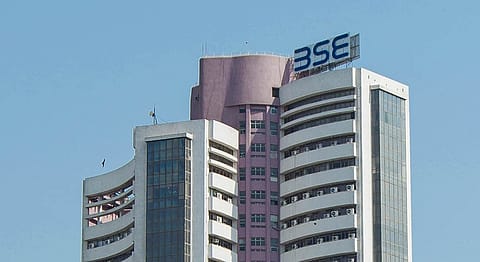Sensex above 80,000: ₹1 lakh in 1986 would have been ₹1 crore this Independence Day
The rise of the Sensex from 100 in 1986 to over 80,000 today has been anything but smooth

As India marks its 79th Independence Day, the country’s leading equity index, the BSE Sensex, remains well above the 80,000 level, highlighting nearly 40 years of compounded growth. Although launched in 1986 with a base of 100, the Sensex has increased by nearly 700–800 times over the years, leading to the doubling of investor wealth approximately every five years.
"From 1986 (Sensex around 550) to today, Indian equities compounded at roughly 13–14% Cagr on price terms—turning ₹1 lakh into ~₹1.3–1.6 crore before dividends," says Nitya Shah, smallcase manager and co-founder of Kamayakya.
Echoing similar views, Ankur Punj, MD and National Sales Head of Equirus Wealth Management, says, “Since the launch of the Sensex in 1986, the Indian market has grown at an average pace of around 14% a year — enough to turn ₹1 lakh then into well over a crore today, even before dividends.”
Beyond the growth figures, experts also highlight shifting market behaviour. "Indian equity markets have come a long way since 1986, and one parameter that stands out is the volatility, which has increased compared to what it used to be in the 1990s, aided by sustained earnings growth and a rise in domestic flows," said Rohit Sarin, co-founder at Client Associates.
The rise of the Sensex from 100 in 1986 to over 80,000 today has been anything but smooth. Over the past four decades, investors have endured some of the most turbulent episodes in India’s market history. Starting with the Harshad Mehta boom and bust in the early ’90s, progressing through the dot-com and Ketan Parekh meltdowns around 2001, the global financial crisis in 2008, and the sharp COVID crash in March 2020.
Shubham Gupta, CFA, co-founder of Growthvine Capital, says, “By the late 1990s and early 2000s, the IT and liberalisation booms powered the Sensex past 5,000 and 6,000 points, fuelled by booming technology exports, surging foreign institutional investment, and India’s increasing integration into the global economy.
Shocks have punctuated the journey. HP Singh, chief managing director of Satin Creditcare, says, "Along the way, markets have faced existential challenges due to various crises like the: Harshad Mehta scam in 1992, which saw a correction of 50% and ultimately led to a host of systemic reforms, and we have moved from strength to strength after the fallout of the international financial crisis happened in 2008; and, most recently, the 38% crash during Covid-19 (March 2020)."
Recommended Stories
Adding to the list of turning points, Shah says, "Markets are inherently cyclical just like business cycles. Investors have witnessed liberalisation policy rally, Lehmann Brothers crisis, demonetisation, GST, IL&FS crisis, post-Covid bull market, Ukraine-Russia conflict, Israel-Palestine conflict, and recently the U.S. tariff policies."
For Punj, the key takeaway has been the market’s ability to rebound stronger after each downturn. "Each of these shocks felt seismic at the time, yet each also cleared the way for the next leg up—powered by reforms, digitisation, rising domestic savings, and the emergence of world-class Indian companies. From a four-digit territory in 1990 to crossing 80,600 now, the Sensex story has been one of resilience.”
Gupta adds, “Most recently, in September 2024, the Sensex hit an all-time high of 85,978, briefly pushing India’s total market capitalisation above $4 trillion. As of mid-2025, it trades near 80,600, up about 8% in the first half of the year despite persistent global volatility. Large-cap leadership, infrastructure spending, and robust corporate earnings continue to drive market strength, while sector rotation and external risks keep volatility elevated.”
Outlook
(INR CR)
Despite occasional setbacks, the Sensex has persisted in its long-term upward trend. "Domestic SIP flows also help maintain strong liquidity. Focussing on earnings growth at the right price will be key to success," says Shah.
Experts believe resilience stems from a mixture of growth, supportive regulation, and robust domestic macro fundamentals. "As we look ahead, structural reform durability, digital inclusion, and financial deepening offer us the best chances of a sustained long-term return despite bumps along the way," says Singh.
Punj offers a note of cautious optimism. "Looking ahead, India’s structural drivers—formalisation, manufacturing/PLI, and steady SIP flows—support equities over the next 3–5 years, but elevated valuations and global rate/geopolitical risks argue for staggered deployment, a quality-and-earnings discipline, and realistic return expectations near mid-teens rather than euphoria. India remains a compelling story—volatile in the short term yet rewarding for the patient. The equity market will keep rewarding patience, but it will test it along the way.”
The Sensex’s four-decade journey is a testament to the compounding power of long-term investing, the structural growth of the Indian economy, and the maturation of its capital markets. “Investors who have remained disciplined through cycles have seen small beginnings transform into substantial wealth, and the index’s trajectory continues to embody resilience, opportunity, and the promise of sustained growth,” Gupta notes.
